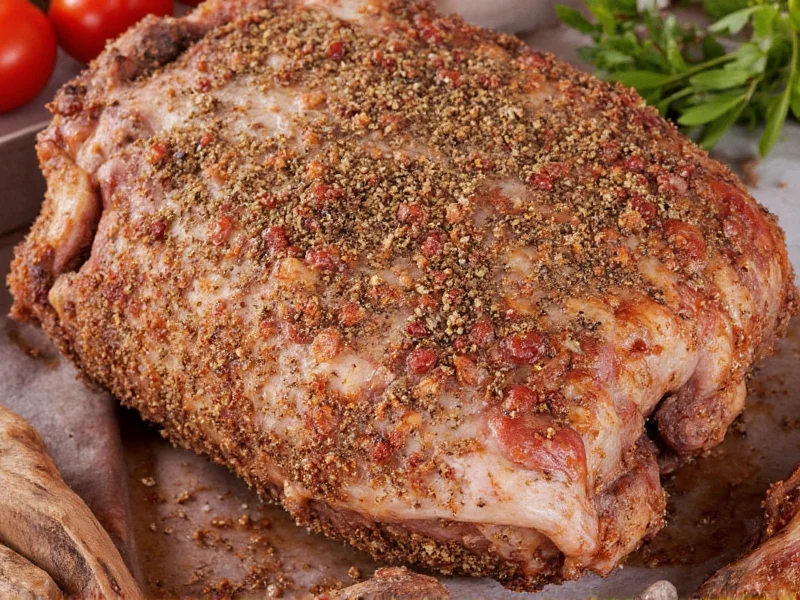Seasoning lamb properly transforms this rich meat into a culinary masterpiece. Many home cooks struggle with balancing flavors that complement lamb's distinctive taste without overwhelming it. Understanding the right herbs, timing, and techniques makes all the difference between ordinary and exceptional results.
Essential Components of Perfect Lamb Seasoning
Lamb has a robust flavor that pairs beautifully with specific herbs and spices. The best herbs for seasoning lamb include rosemary, thyme, and mint—each bringing unique characteristics that enhance rather than mask the meat's natural richness.
Garlic provides depth without overpowering, while coarse salt draws out moisture initially then helps form a flavorful crust during cooking. Freshly ground black pepper adds subtle heat and complexity. Olive oil serves as the perfect carrier for these flavors, helping them adhere to the meat and facilitating even browning.
Regional Seasoning Traditions
Cultures worldwide have developed distinctive approaches to seasoning lamb. Understanding these traditions helps you select the perfect flavor profile for your dish:
- Mediterranean style: Focuses on rosemary, garlic, lemon zest, and olive oil—ideal for leg of lamb or chops
- Middle Eastern approach: Uses cumin, coriander, sumac, and mint—perfect for ground lamb or shoulder cuts
- French herb crust: Combines parsley, thyme, and Dijon mustard—excellent for rack of lamb
- Asian-inspired variation: Features ginger, soy sauce, and five-spice powder—works well with lamb loin
Timing Matters: When to Season Lamb
How to make lamb seasoning rub effective depends significantly on timing. For dry rubs, apply at least 1 hour before cooking—up to 24 hours for larger cuts like leg of lamb. This allows salt to penetrate and season the interior while herbs infuse their flavors.
Wet marinades should generally not exceed 8-12 hours, as the acid can begin to break down the meat's texture. For delicate cuts like chops, 2-4 hours provides optimal flavor without texture changes.
Professional chefs often recommend a two-stage approach: initial seasoning with salt 24 hours before cooking (refrigerated), followed by additional herbs and oil 1-2 hours before cooking. This technique maximizes flavor penetration while preserving texture.
Seasoning Ratios for Perfectly Flavored Lamb
Getting the proportions right is crucial for traditional lamb seasoning techniques. The following table provides reliable starting points that you can adjust to taste:
| Seasoning Component | Per Pound of Lamb | Notes |
|---|---|---|
| Coarse salt | 1 teaspoon | Use kosher salt for even distribution |
| Fresh rosemary | 1 tablespoon, chopped | Stems removed; more for leg cuts |
| Garlic | 2 cloves, minced | Raw for stronger flavor, roasted for milder |
| Olive oil | 1 tablespoon | Extra virgin for raw applications |
| Black pepper | ½ teaspoon, freshly ground | Add after other seasonings |
Avoiding Common Seasoning Mistakes
Many home cooks make critical errors when seasoning lamb that diminish results. When to season lamb before cooking is often misunderstood—applying salt too close to cooking time doesn't allow proper penetration.
Over-marinating with acidic ingredients like lemon juice or vinegar can create an unpleasantly soft texture. For most cuts, never exceed 12 hours in an acid-based marinade. Delicate cuts like chops need even less time.
Using dried herbs instead of fresh significantly reduces flavor impact. If substituting dried for fresh, use one-third the amount (1 teaspoon dried rosemary equals 1 tablespoon fresh). Dried herbs work better in long-cooking dishes like stews, while fresh shines on grilled or roasted preparations.
Advanced Techniques from Professional Kitchens
Master chefs employ several sophisticated methods for seasoning lamb chops properly. One technique involves creating a paste with herbs, garlic, and mustard that forms a protective crust during high-heat cooking, locking in juices while adding flavor.
Another professional approach uses layered seasoning: salt applied 24 hours in advance, followed by a dry rub 4 hours before cooking, then a final oil and herb application just before it hits the pan or grill. This creates depth of flavor throughout the meat rather than just on the surface.
For special occasions, consider infusing your olive oil with herbs and garlic by gently heating (never boiling) the oil with your aromatics, then cooling before using as the base for your seasoning mixture. This extracts maximum flavor compounds without bitterness from raw garlic.
Adjusting for Different Cuts
Lamb shoulder benefits from bolder seasoning with additional garlic and cumin due to its stronger flavor and connective tissue. Lamb leg seasoning recommendations typically include more rosemary and lemon to complement its leaner profile.
Fattier cuts like lamb belly can handle stronger acidic components, while delicate loin requires more subtle seasoning. Always consider the cooking method—grilled lamb needs more robust seasoning than braised preparations, as some flavors dissipate during high-heat cooking.











 浙公网安备
33010002000092号
浙公网安备
33010002000092号 浙B2-20120091-4
浙B2-20120091-4